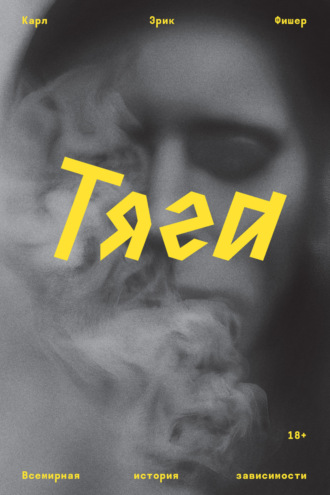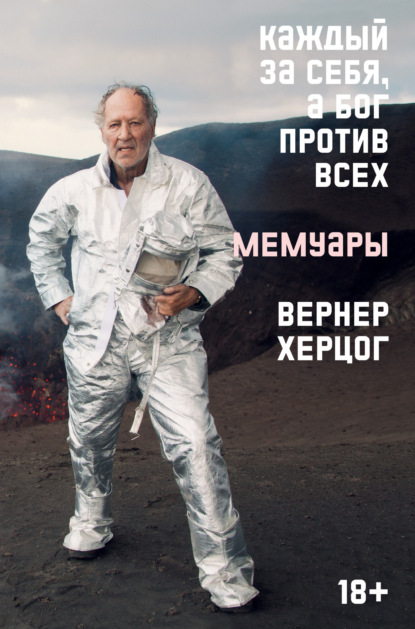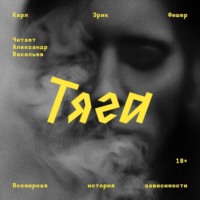
Полная версия
Тяга. Всемирная история зависимости
41
Karen Armstrong, The Case for God (New York: Knopf, 2009), 111.
42
Piyadassi Thera, trans., Dhammacakkappavattana Sutta: Setting in Motion the Wheel of Truth, SN 56.11, Access to Insight, https://www.accesstoinsight.org/tipitaka/sn/sn56/sn56.011.piya.html. «Словом, пять скандх – страдание.
Теперь, о монахи, Благородная Истина о Возникновении Страдания. Оно – в жажде, в алчбе, которые производят новое существование, связано оно с наслаждением и страстью. Алчба всегда находит себе удовлетворение то здесь, то там. Это – жажда наслаждения, жажда существования и жажда несуществования, самоизбывания» (Дхармачакра правартана сутра, пер. А. М. Пятигорского). См. также Chonyi Taylor, Enough! A Buddhist Approach to Finding Release from Addictive Patterns (Ithaca, NY: Snow Lion, 2010); Darren Littlejohn, The 12-Step Buddhist: Enhance Recovery from Any Addiction (New York: Atria, 2009).
43
Vince Cullen, trans., Roga Sutta, AN 4.157 (неопубликованный перевод, 2019), подготовленный для Международного саммита по буддийским практикам в лечении зависимости (International Buddhist Recovery Summit). Текст перевода на английский язык доступен онлайн: Bhikkhu Sujato, trans., Roga Sutta, AN 4.157, https://suttacentral.net/an4.157/en/sujato. Винс Каллен использует слова «пьянящая тяга» (intoxicating inclinations) для перевода слова Asava вслед за Питером Харви, см. Peter Harvey, “In Search of the Real Buddha,” Buddhist News, November 28, 2019, https://thebuddhist.news/headline-news/in-search-of-the-real-buddha/; Peter Harvey, Introduction to Buddhism (New York: Cambridge University Press, 2013).
44
Brendan Dill and Richard Holton, “The Addict in Us All,” Frontiers in Psychiatry, October 9, 2014, https://www.frontiersin.org/articles/10.3389/fpsyt.2014.00139/full.
45
Stephen C. Hayes, Kirk D. Strosahl, and Kelly G. Wilson, Acceptance and Commitment Therapy: The Process and Practice of Mindful Change, 2nd ed. (New York: Guilford Press, 2012), vii–x, 95–98. См. также Caroline Davis and Gordon Claridge, “The Eating Disorders as Addiction: A Psychobiological Perspective,” Addictive Behaviors 23, no. 4 (July 1, 1998): 463–475, https://doi.org/10.1016/S0306–4603(98)00009–4; Jason Luoma et al., “Substance Abuse and Psychological Flexibility: The Development of a New Measure,” Addiction Research & Theory 19, no. 1 (February 1, 2011): 3–13, https://doi.org/10.3109/16066359.2010.524956; Manuel Alcaraz-Ibáñez, José M. Aguilar-Parra, and Joaquín F. Álvarez-Hernández, “Exercise Addiction: Preliminary Evidence on the Role of Psychological Inflexibility,” International Journal of Mental Health and Addiction 16, no. 1 (February 1, 2018): 199–206, https://doi.org/10.1007/s11469–018–9875-y; Wei-Po Chou, Cheng-Fang Yen, Tai-Ling Liu, “Predicting Effects of Psychological Inflexibility/ Experiential Avoidance and Stress Coping Strategies for Internet Addiction, Significant Depression, and Suicidality in College Students: A Prospective Study,” International Journal of Environmental Research and Public Health 15, no. 4 (April 2018): 788, https://doi.org/10.3390/ijerph15040788. Это понятие перекликается с результатами как теоретических исследований, так и экспериментов по применению психоделиков в лечении психических заболеваний, см. Judson Brewer, The Craving Mind: From Cigarettes to Smartphones to Love – Why We Get Hooked and How We Can Break Bad Habits (New Haven, CT: Yale University Press, 2017), 115; Michael Pollan, How to Change Your Mind: What the New Science of Psychedelics Teaches Us about Consciousness, Dying, Addiction, Depression, and Transcendence (New York: Penguin Press, 2018), 358–368.
46
Подробнее о самопомощи и нежелательности ее слишком поверхностного восприятия см. West and Brown, Theory of Addiction, 49–51.
47
Peter Zachar and Kenneth S. Kendler, “Psychiatric Disorders: A Conceptual Taxonomy,” American Journal of Psychiatry 164, no. 4 (April 2007): 57–65, https://doi.org/10.1176/ajp.2007.164.4.557; Nick Haslam, “Psychiatric Categories as Natural Kinds: Essentialist Thinking about Mental Disorder,” Social Research 67, no. 4 (Winter 2000): 1031–1058.
48
Deborah Hasin, “Truth (Validity) and Use Despite Consequences: The DSM-5 Substance Use Disorder Unidimensional Syndrome,” Addiction 109, no. 11 (November 2014): 1781–1782, https://doi.org/10.1111/add.12686; Deborah Hasin, “DSM-5 SUD Diagnoses: Changes, Reactions, Remaining Open Questions,” Drug and Alcohol Dependence 148, no. 3 (March 1, 2015): 226–229, https://doi.org/10.1016/j.drugalcdep.2014.12.006; Deborah Hasin et al., “DSM-5 Criteria for Substance Use Disorders: Recommendations and Rationale,” American Journal of Psychiatry 170, no. 8 (August 1, 2013): 834, https://doi.org/10.1176/appi.ajp.2013.12060782.
49
Steve Silberman, NeuroTribes: The Legacy of Autism and the Future of Neurodiversity (New York: Avery, 2015); Christina Nicolaidis, “What Can Physicians Learn from the Neurodiversity Movement?” AMA Journal of Ethics 14, no. 6 (June 2012): 503–510, https://doi.org/10.1001/virtualmentor.2012.14.6.oped1–1206. Более общую информацию о концепции спектра см. в работах Thomas Insel et al., “Research Domain Criteria (RDoC): Toward a New Classification Framework for Research on Mental Disorders,” American Journal of Psychiatry 167, no. 7 (July 2010): 748–751, https://doi.org/10.1176/appi.ajp.2010.09091379; William E. Narrow, Emily A. Kuhl, “Dimensional Approaches to Psychiatric Diagnosis in DSM-5,” Journal of Mental Health Policy and Economics 14, no. 4 (December 2011): 197–200, PMID: 22345361; Kristian E. Markon, Michael Chmielewski, Christopher J. Miller, “The Reliability and Validity of Discrete and Continuous Measures of Psychopathology: A Quantitative Review,” Psychological Bulletin 137, no. 5 (2011): 856–879, https://doi.apa.org/doi/10.1037/a0023678; Michael P. Hengartner, Sandrine N. Lehmann, “Why Psychiatric Research Must Abandon Traditional Diagnostic Classification and Adopt a Fully Dimensional Scope: Two Solutions to a Persistent Problem,” Frontiers in Psychiatry 8 (June 2017), https://doi.org/10.3389/fpsyt.2017.00101.
50
Reinout W. Wiers and Paul Verschure, “Curing the Broken Brain Model of Addiction: Neurorehabilitation from a Systems Perspective,” Addictive Behaviors 112 (January 2021): 106602, https://doi.org/10.1016/j.addbeh.2020.106602.
51
William S. Burroughs, Junky, ed. Oliver Harris (New York: Penguin Classics, 2008), 128; Caroline Knapp, Drinking: A Love Story (New York: Dial Press, 1996), 104, цит. по Jason David Gray, “Philosophy, Phenomenology, and Neuroscience: The Groundwork for an Interdisciplinary Approach to a Comprehensive Understanding of Addiction” (PhD diss., University of California, Riverside, 2013), 88.
52
У. Берроуз, «Джанки», пер. А. Керви и М. Смеляка.
53
Owen Flanagan, “What Is It Like to Be an Addict?” in Addiction and Responsibility, ed. Jeffrey Poland and George Graham (Cambridge, MA: MIT Press, 2011), 275.
54
Augustine, Confessions, 8.5.1.
55
E. M. Jellinek, The Disease Concept of Alcoholism (New Haven, CT: Hillhouse Press, 1960), 41.
56
Heather, “Addiction as a Form of Akrasia.”
57
О проблеме ретроспективной диагностики см. Axel Karenberg, “Retrospective Diagnosis: Use and Abuse in Medical Historiography,” Prague Medical Report 110, no. 2 (2009): 140–145.
58
Marcus Tullius Cicero, Selected Works, trans. Michael Grant (New York: Penguin Classics, 1960), 129. Приводя эту цитату, следует, однако, отметить, что Цицерон был заклятым врагом Марка Антония.
59
Цитата из второй филиппики дана в переводе В. О. Горентшейна.
60
Seneca, Moral Letters to Lucilius, 83.25, https://en.wikisource.org/wiki/Moral_letters_to_Lucilius/Letter_83.
61
Quintus Curtius Rufus, History of Alexander the Great of Macedon, 5.7.1; Marcus Junianus Justinus, Epitome of the Phillipic History of Pompeius Trogus, trans. John Selby Watson (London, 1853), 9.8.15, http://www.forumromanum.org/literature/justin/english/index.html. Питер Грин, автор современной биографии Александра Македонского, часто указывает в тексте на «алкоголизм» великого полководца: см. Peter Green, Alexander of Macedon, 356–323 B. C. (Berkeley: University of California Press, 1991), 443, 453. Джон О’Брайен утверждает, что Александр демонстрировал все классические симптомы алкоголизма и именно это стало причиной его падения, его «главной проблемой»: John O’Brien, Alexander the Great: The Invisible Enemy (New York: Routledge, 1992), 230.
62
Ryan P. McCormack et al., “Commitment to Assessment and Treatment: Comprehensive Care for Patients Gravely Disabled by Alcohol Use Disorders,” Lancet 382, no. 9896 (September 2013): 995–997, https://doi.org/10.1016/s0140–6736(12)62206–5
63
Nick Heather, “On Defining Addiction,” в кн. Heather and Segal, Addiction and Choice, 3–28; Michael S. Moore, “Addiction, Responsibility, and Neuroscience,” University of Illinois Law Review 202, no. 2: 375–470, https://illinoislawreview.org/wp-content/uploads/2020/04/Moore.pdf. Нельзя не отметить, что критерии, которые считаются объективными, тем не менее содержат оценочные суждения, поскольку включают в себя такие понятия, как «проблемы» и «много времени».
64
Отметим, что критерии расстройства употребления психоактивных веществ нельзя назвать абсолютно надежными, см. Deborah Hasin et al., “The DSM-5 Field Trials and Reliability of Alcohol Use Disorder,” Drug and Alcohol Dependence 148 (March 2015): 226–229, https://doi.org/10.1016/j.drugalcdep.2014.12.006.
65
Harry G. Frankfurt, “Freedom of the Will and the Concept of a Person,” Journal of Philosophy 68, no. 1 (January 1971): 12, https://doi.org/10.2307/2024717.
66
Herbert Fingarette, “Philosophical and Legal Aspects of the Disease Concept of Alcoholism,” in Research Advances in Alcohol and Drug Problems, vol. 7, ed. Reginald G. Smart et al. (New York: Plenum Press, 1983), 4.
67
Jose Murgatroyd Cree, “Protestant Evangelicals and Addiction in Early Modern English,” Renaissance Studies 32, no. 3 (June 2018): 446–462, https://doi.org/10.1111/rest.12328; Jose Murgatroyd Cree, “The Invention of Addiction in Early Modern England” (PhD diss., University of Sheffield, 2018). См. также Augustus Charles Bickley, “John Frith,” в кн. Dictionary of National Biography, ed. Leslie Stephen (London: Smith, Elder, 1889), https://en.wikisource.org/wiki/Frith,_John_(DNB00); Thomas Russell, “The Story, Life, and Martyrdom of John Frith, with the Godly and Learned Works and Writings of the Said Author, Hereafter Appearing,” в кн. The Works of the English Reformers: William Tyndale and John Frith, ed. Thomas Russell (London: Ebenezer Palmer, 1831), 2:77, https://archive.org/details/theworksoftheeng03tynduoft/page/n7/mode/2up.
68
Rebecca Lemon, Addiction and Devotion in Early Modern England (Philadelphia: University of Pennsylvania Press, 2018), ix.
69
Cree, “Protestant Evangelicals,” 3.
70
John Frith, Antithesis […], in Russell, Works of the English Reformers, 318 (курсив наш).
71
Cree, “The Invention of Addiction,” chap. 4. Говоря точнее, слово пришло из новой латыни, где оно уже приобрело значение, в котором его использовал Фрит.
72
Cree, “Protestant Evangelicals,” 174, 448.
73
Cree, “Protestant Evangelicals,” 455.
74
Lemon, Addiction and Devotion, 10.
75
Gabriel, “Gods and Monsters,” 86–90; Christopher Cook, Alcohol, Addiction, and Christian Ethics (New York: Cambridge University Press, 2006); Mariana Valverde, Diseases of the Will: Alcohol and the Dilemmas of Freedom (New York: Cambridge University Press, 1998).
76
Rebecca Lemon, “Scholarly Addiction: Doctor Faustus and the Drama of Devotion,” Renaissance Quarterly 69, no. 3 (Fall 2016): 865–898, https://doi.org/10.1086/689036; Genevieve Guenther, “Why Devils Came When Faustus Called Them,” Modern Philology 109, no. 1 (August 2011): 46–70, https://doi.org/10.1086/662147.
77
Henri Logeman, ed., The English Faust-Book of 1592 (Ghent, 1900), 1, https://books.google.com/books?id=Q0RHAAAAcAAJ.
78
Laurence Bergreen, Columbus: The Four Voyages, 1492–1504 (New York: Penguin, 2012), 26–28.
79
Bergreen, Columbus, 19, 27; Count Corti, A History of Smoking, trans. Paul England (New York: Harcourt, Brace, 1932), 35–39. На самом деле первые листья табака дали Колумбу таино, жившие на Багамах, но тот подарок он выкинул.
80
Rudi Mathee, “Exotic Substances: The Introduction and Global Spread of Tobacco, Coffee, Cocoa, Tea, and Distilled Liquor, Sixteenth to Eighteenth Centuries,” в кн. Drugs and Narcotics in History, ed. Roy Porter and Mikulás Teich (New York: Cambridge University Press, 1995), 33.
81
Zachary Siegel, “Is the U. S. Knee-Deep in ‘Epidemics,’ or Is That Just Wishful Thinking?” New York Times, August 14, 2018, https://www.nytimes.com/2018/08/14/magazine/epidemic-disaster-tragedy.html.
82
David T. Courtwright, Forces of Habit: Drugs and the Making of the Modern World (Cambridge, MA: Harvard University Press, 2001), 1–6.
83
Jordan Goodman, “Excitantia: Or, How Enlightenment Europe Took to Soft Drugs,” в кн. Consuming Habits: Global and Historical Perspectives on How Cultures Define Drugs, 2nd ed., ed. Jordan Goodman, Paul E. Lovejoy, and Andrew Sherratt (New York: Routledge, 2007), 121. О сахаре: см. Andrew Sherratt, введение к кн. Consuming Habits, 7.
84
Garcia da Orta, Colloquies on the Simples & Drugs of India, ed. Conde de Ficalho, trans. Clements Markham (Lisbon, 1895), https://archive.org/stream/colloquiesonsimp00orta/colloquiesonsimp00orta_djvu.txt. («Мужчины, принимающие его, становятся вялыми и сонными, они говорят, что употребляют, чтобы не чувствовать проблем… Если не дать им его, есть риск летального исхода… и среди тех, кто его употребляет, распространена сильная тяга к нему»). См. также Benjamin Breen, The Age of Intoxication: Origins of the Global Drug Trade (Philadelphia: University of Pennsylvania Press, 2019), 58–59; Marcus Boon, The Road of Excess: A History of Writers on Drugs (Cambridge, MA: Harvard University Press, 2005), гл. 1.
85
Именно от имени Жана Нико происходит слово «никотин». Larry Harrison, “Tobacco Battered and the Pipes Shattered: A Note on the Fate of the First British Campaign against Tobacco Smoking,” British Journal of Addiction 81, no. 4 (April 1986): 553–558, https://doi.org/10.1111/j.1360–0443.1986.tb00367.x.
86
Corti, History of Smoking, 69; Alfred H. Dunhill, “Smoking in England – Elizabethan,” в кн. The Gentle Art of Smoking (New York: Putnam, 1954), https://web.archive.org/web/20181109095246/http://archive.tobacco.org:80/History/Elizabethan_Smoking.html; Iain Gately, Tobacco: A Cultural History of How an Exotic Plant Seduced Civilization (New York: Grove Press, 2001), 45.
87
Patrizia Russo et al., “Tobacco Habit: Historical, Cultural, Neurobiological, and Genetic Features of People’s Relationship with an Addictive Drug,” Perspectives in Biology and Medicine 54, no. 4 (Autumn 2011): 557–577, https://doi.org/10.1353/pbm.2011.0047. В частности, папа угрожал отлучением тем, кто употреблял нюхательный табак прямо в церкви: J. D. Rolleston, “On Snuff Taking,” British Journal of Inebriety 34, no. 1 (July 1936): 1–16.
88
Carol Benedict, Golden-Silk Smoke: A History of Tobacco in China, 1555–2010 (Berkeley: University of California Press, 2011), 24; Corti, History of Smoking, 141.
89
David Courtwright, The Age of Addiction: How Bad Habits Became Big Business (Cambridge, MA: Harvard University Press, 2019), 70. См. также James Grehan, “Smoking and ‘Early Modern’ Sociability: The Great Tobacco Debate in the Ottoman Middle East (Seventeenth to Eighteenth Centuries),” American Historical Review 111, no. 5 (December 2006): 1352–1377, https://doi.org/10.1086/ahr.111.5.1352.
90
King James I, A Counterblaste to Tobacco (London, 1604), 16, https://books.google.com/books?id=EasUAAAAYAAJ. См. также David Harley, “The Beginnings of the Tobacco Controversy: Puritanism, James I, and the Royal Physicians,” Bulletin of the History of Medicine 67, no. 1 (Spring 1993): 28–50, PMID: 8461637.
91
Joshua Sylvester, Tobacco Battered and the Pipes Shattered (About Their Ears, That Id’ly Idolize So Base and Barbarous a Weed: Or, at Least-Wise Over-Love So Loathsome Vanity) (London, 1676; Ann Arbor, MI: Text Creation Partnership, 2011), https://quod.lib.umich.edu/e/eebo/A87472.0001.001/1:6?rgn=%20div1;view=fulltext.
92
OxyContin: Its Use and Abuse, Hearing before the Subcommittee on Oversight and Investigations of the Committee on Energy and Commerce, House of Representatives, 107th Cong. 54 (2001) (обработанные показания Майкла Фридмана, исполнительного вице-президента, главного операционного директора Purdue Pharma L. P.). Более подробную информацию о нынешнем опиоидном кризисе можно найти в работе Patrick Radden Keefe, “The Family That Built an Empire of Pain,” New Yorker, October 30, 2017, https://www.newyorker.com/magazine/2017/10/30/the-family-that-built-an-empire-of-pain; Barry Meier, Pain Killer: An Empire of Deceit and the Origin of America’s Opioid Epidemic (New York: Random House, 2003); Sam Quinones, Dreamland: The True Tale of America’s Opiate Epidemic (New York: Bloomsbury Press, 2015); Anne Case and Angus Deaton, Deaths of Despair and the Future of Capitalism (Princeton, NJ: Princeton University Press, 2020); Art Van Zee, “The Promotion and Marketing of OxyContin: Commercial Triumph, Public Health Tragedy,” American Journal of Public Health 99, no. 2 (February 2009): 221–227, https://doi.org/10.2105/AJPH.2007.131714.
93
Gerald Posner, “How to Hold Purdue Pharma Accountable for Its Role in the Opioid Epidemic,” Los Angeles Times, May 17, 2020, https://www.latimes.com/opinion/story/2020–05–17/sacklers-opioid-epidemic-bankruptcy; Katie Benner, “Purdue Pharma Pleads Guilty to Role in Opioid Crisis as Part of Deal with Justice Dept.,” New York Times, November 24, 2020, https://www.nytimes.com/2020/11/24/us/politics/purdue-pharma-opioids-guilty-settlement.html; “2020 America’s Richest Families Net Worth – #30 Sackler Family,” Forbes, December 16, 2020, https://www.forbes.com/profile/sackler/?sh=53c8914b5d63.
94
Jim Orford, Power, Powerlessness, and Addiction (New York: Cambridge University Press, 2013), 131.
95
William Rhodes et al., Illicit Drugs: Price Elasticity of Demand and Supply (Washington, DC: National Criminal Justice Reference Service, 2002), 60–67, https://www.ojp.gov/pdffiles1/nij/grants/191856.pdf.
96
Jonathan P. Caulkins and Rosalie Liccardo Pacula, “Marijuana Markets: Inferences from Reports by the Household Population,” Journal of Drug Issues 38, no. 1 (January 2006): 173–200, https://doi.org/10.1177/002204260603600108. Автор подчеркивает, что намеренно употребляет слово «каннабис» для обозначения марихуаны, так как оно является научным названием растения, а кроме того, было в ходу задолго до того, как появилось слово «марихуана», которое намеренно использовалось для распространения негативных и расистских ассоциаций с этим веществом.
97
Alfred Rive, “A Brief History of the Regulation and Taxation of Tobacco in England,” William and Mary Quarterly 9, no. 1 (January 1929), https://doi.org/10.2307/1920374; Mathee, “Exotic Substances,” 33.
98
Harrison, “Tobacco Battered,” 556.
99
Courtwright, Forces of Habit, 156; Corti, History of Smoking, 141.
100
Corti, History of Smoking, 149.
101
Courtwright, Forces of Habit, 4–5.
102
Courtwright, Forces of Habit, 156, 197.
103
Orford, Power, Powerlessness, and Addiction.
104
Peter C. Mancall, “Tales Tobacco Told in Sixteenth-Century Europe,” Environmental History 9, no. 4 (2004): 648–78, https://doi.org/10.2307/3986264; Marcy Norton, Sacred Gifts, Profane Pleasures: A History of Tobacco and Chocolate in the Atlantic World (Ithaca, NY: Cornell University Press, 2008), 221–222.
105
Harrison, “Tobacco Battered,” 557.
106
Sidney W. Mintz, Sweetness and Power: The Place of Sugar in Modern History (New York: Penguin, 1986); James Walvin, Sugar, the World Corrupted: From Slavery to Obesity (New York: Pegasus, 2018).
107
Joseph F. Spillane, Cocaine: From Medical Marvel to Modern Menace in the United States, 1884–1920 (Baltimore: Johns Hopkins University Press, 2000), 32. См. также David F. Musto, “Opium, Cocaine and Marijuana in American History,” Scientific American, July 1991, https://doi.org/10.1038/scientificamerican0791–40. О компании Merck: H. Richard Friman, “Germany and the Transformations of Cocaine, 1860–1920,” в кн. Cocaine: Global Histories, ed. Paul Gootenberg (New York: Routledge, 2002), 85.
108
René I. Jahiel and Thomas F. Babor, “Industrial Epidemics, Public Health Advocacy and the Alcohol Industry: Lessons from Other Fields,” Addiction 102, no. 9 (September 2007): 1335–1339, https://doi.org/10.1111/j.1360–0443.2007.01900.x.
109
Richard Kluger, Ashes to Ashes: America’s Hundred-Year Cigarette War, the Public Health, and the Unabashed Triumph of Philip Morris (New York: Vintage, 1997), гл. 4–9.
110
Автор неизвестен, записка предназначалась Р. А. Питтману, 21 августа 1969, Brown & Williamson Records, Truth Tobacco Industry Records, University of California, San Francisco, https://www.industrydocuments.ucsf.edu/tobacco/docs/#id=xqkd0134; David Michaels, Doubt Is Their Product (New York: Oxford University Press, 2008).
111
Graham Readfearn, “Doubt over Climate Science Is a Product with an Industry behind It,” Guardian, March 5, 2015, https://www.theguardian.com/environment/planet-oz/2015/mar/05/doubt-over-climate-science-is-a-product-with-an-industry-behind-it; David Michaels, The Triumph of Doubt: Dark Money and the Science of Deception (New York: Oxford University Press, 2020).
112
Frederick Turner, Ernst Pöppel, “The Neural Lyre: Poetic Meter, the Brain, and Time,” Poetry 142, no. 5 (August 1983): 277–309, https://www.jstor.org/stable/20599567.







